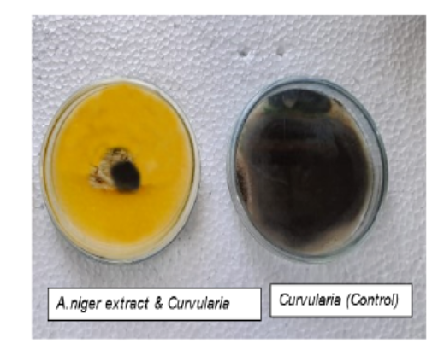


Indian Journal of Science and Technology
DOI: 10.17485/IJST/v16i14.2395
Year: 2023, Volume: 16, Issue: 14, Pages: 1090-1098
Original Article
K Sabina1*, S Gayathridevi1, S Pavithraa2
1Assistant Professor, Department of Microbiology, Prince Shri Venkateshwara Arts and Science College, Gowrivakkam, Chennai, 600073, Tamil Nadu, India
2Director and trainer, TPSJ Academy, Chennai, Tamil Nadu, India
*Corresponding Author
Email: [email protected]
Received Date:13 December 2022, Accepted Date:04 March 2023, Published Date:17 April 2023
Objectives: To explore the antagonistic activity of rhizospheric fungi against the phytopathogens of Solanum melongena (Brinjal) and Citrus sinensis (Orange), as these diseases cause major economic loss in the respective plants. Methods: Phytopathogens were isolated from infected leaves and fruits. Fungi were isolated from the rhizosphere of respective plants. Fungal isolates were screened for antagonism against phytopathogens and positive isolates were identified. Assays were conducted for volatile and non-volatile compounds from the antagonistic fungi and antagonistic metabolites were extracted. Antagonistic extracts were characterized and confirmed the antagonistic activity of the extract against the phytopathogens. Findings: Phytopathogens were identified as Curvularia sp. and Penicillium sp. Among the 12 rhizospheric fungal isolates, A. niger, A. fumigatus and A. flavus exhibited good antagonistic activity against the phytopathogens. The non-volatile metabolites were mostly responsible for antagonism when compared to the volatiles. The non-volatile compounds from A. niger showed highest activity against Curvularia (95% inhibition) followed by A. flavus (79%) and A. fumigatus (76%). This study demonstrates the potential applications of antagonistic fungi as effective biocontrol agents against various phytopathogens. Novelty: As high as 95% inhibition of phytopathogens was observed in the study which suggests the effectiveness of non-volatile metabolites from antagonistic fungi as potent biocontrol agents to prevent the crop-loss.
Keywords: Antagonism; Antagonistic Metabolites; Phytopathogens; Rhizospheric Fungi; Volatile Assays
© 2023 Sabina et al. This is an open-access article distributed under the terms of the Creative Commons Attribution License, which permits unrestricted use, distribution, and reproduction in any medium, provided the original author and source are credited. Published By Indian Society for Education and Environment (iSee)
Subscribe now for latest articles and news.